Abandoned telephone cables are contaminating soil and waterways throughout the U.S. with toxic lead, according to an in-depth report from the Wall Street Journal.
The investigation, which has since been partly disputed by the EPA in response to the WSJ report, found thousands of lead-covered cables left behind by major telecom companies have been polluting the environment for decades, posing a hidden threat to communities from coast to coast.
The worst part is that these companies knew the dangers of these toxic cables, yet didn't do anything about the potential health risk.
What's happening?
After researchers tested hundreds of sites nationwide, environmental samples revealed lead contamination near playgrounds, schools, and major waterways. A sample from Lake Tahoe reported levels 2,533 times the EPA limit for drinking water, posing a significant danger to swimmers, wildlife, and nearby communities.
In 2021, AT&T settled a lawsuit concerning 8 miles of degrading phone cable leaching lead into the lake that is split between California and Nevada, the Associated Press reported. The company agreed to remove the cable as part of the settlement but hasn't yet done so.
Why are lead cables so concerning?
According to the World Health Organization, lead is a toxin that builds up in the body, causing harmful effects with even small amounts of exposure. Lead in the body is especially damaging to the brain, liver, kidneys, and bones. Infants and children are particularly vulnerable to lead poisoning as the toxic metal impairs the development of the brain and nervous system, resulting in problems ranging from behavioral disorders to difficulty learning.
Despite decades of work to eliminate lead from homes and water lines, lead-coated phone cables remain mostly unaddressed.
Jack Caravanos, an NYU environmental public-health professor, explained to the Wall Street Journal, as reported by Futurism, "We never knew about it so we never acted on it, unlike lead in paint and pipes."
Following the report, telecom giants like AT&T and Verizon responded with little action. Contradicting public statements, internal messages from AT&T showed the company recognized the potential danger for workers exposed to the lead cables but remained reluctant to remove the deteriorating phone lines.
What's being done about the toxic cables?
For its part, USTelecom said in a statement to The Cool Down that it believes the cables are safe, pointing to some EPA testing sites that the organization said indicated there was no immediate health risk: "The U.S. telecom industry prioritizes the health and safety of its communities and workers. The industry is engaging with stakeholders, including policymakers, on this important matter and sharing relevant information as it becomes available. We will continue to follow the science, which has not identified that legacy lead-sheathed telecom cables are a leading cause of lead exposure or the cause of a public health issue. And recent federal and state testing at particular sites has reinforced this point. Our industry remains committed to engaging constructively on this issue."
In the wake of the report, though, environmental groups are calling on the government to further investigate the potential danger to people and the environment if these cables are not removed. The abandoned cables are a stark reminder of the need for better ways to safely dispose of or recycle outdated technology while holding companies accountable for putting the health of our communities at risk.
While the EPA said its testing has not shown the same results as the WSJ report's, the national agency said it formed a working group to review ways to ensure public safety on this matter.
Join our free newsletter for cool news and cool tips that make it easy to help yourself while helping the planet.









